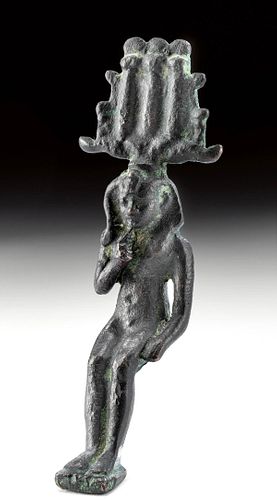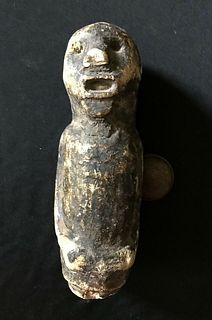Egyptian Bronze Seated Horus / Harpokrates
Lot 7
About Seller
Artemis Fine Arts
686 S Taylor Ave, Ste 106
Louisville, CO 80027
United States
Selling antiquities, ancient and ethnographic art online since 1993, Artemis Gallery specializes in Classical Antiquities (Egyptian, Greek, Roman, Near Eastern), Asian, Pre-Columbian, African / Tribal / Oceanographic art. Our extensive inventory includes pottery, stone, metal, wood, glass and textil...Read more
Estimate:
$800 - $1,500
Absentee vs Live bid
Two ways to bid:
- Leave a max absentee bid and the platform will bid on your behalf up to your maximum bid during the live auction.
- Bid live during the auction and your bids will be submitted real-time to the auctioneer.
Bid Increments
| Price | Bid Increment |
|---|---|
| $0 | $25 |
| $300 | $50 |
| $1,000 | $100 |
| $2,000 | $250 |
| $5,000 | $500 |
| $10,000 | $1,000 |
| $20,000 | $2,500 |
| $50,000 | $5,000 |
| $100,000 | $10,000 |
| $200,000 | $20,000 |
About Auction
By Artemis Fine Arts
Oct 22, 2020
Set Reminder
2020-10-22 10:00:00
2020-10-22 10:00:00
America/New_York
Bidsquare
Bidsquare : Ancient & Ethnographic Art Through The Ages
https://www.bidsquare.com/auctions/artemis-gallery/ancient-ethnographic-art-through-the-ages-5850
Ancient art from Egypt, Greece, Italy and the Near East, as well as Asian, Fossils, Pre-Columbian, Native American, African / Tribal / Oceanic, Fine art, and much more! All categories, all price ranges... all legally acquired and guaranteed to be as described or your money back. Artemis Fine Arts info@artemisgallery.com
Ancient art from Egypt, Greece, Italy and the Near East, as well as Asian, Fossils, Pre-Columbian, Native American, African / Tribal / Oceanic, Fine art, and much more! All categories, all price ranges... all legally acquired and guaranteed to be as described or your money back. Artemis Fine Arts info@artemisgallery.com
- Lot Description
Egypt, Ptolemaic period, ca. 332 to 30 BCE. A striking solid cast-copper alloy statuette of the child god Horus/Harpokrates (from the Egyptian "Her-pa-khered" or "Horus the Child") seated nude with slightly bent legs and feet planted atop an integral rectangular plinth. With his left arm resting parallel to his body, he holds his right index finger to his mouth, a fitting pose for the god of silence. His youthful visage exhibits almond eyes, a button nose, full smirking lips, and a curled sidelock of youth draped on one side. He wears a nemes wig cover with two frontal lappets and a hemhem (hemhemet or Atef) crown on top consisting of a trio of "mw" crowns topped with sun discs and flanked with ostrich feathers. A small serpent, called a uraeus and symbolizing supreme power, peers out from the top of his head, alluding to his future kingship. The well-formed figure is a lustrous dark copper with scattered areas of green patina adding a touch of color. Size w/ Included Custom Stand: 1.75" L x 2" W x 3.375" H (4.4 cm x 5.1 cm x 8.6 cm)
Harpokrates (also Harpocrates) was, in many ways, one of the most popular deities in the Egyptian pantheon for centuries on end. The offspring of Osiris and Isis, Harpokrates was originally thought to be a protective deity, warding dangerous magic and creatures away from the wielder of his effigy. His depiction as a child was a common sight in ancient Egypt as infantile gods were favored to their adult characterizations from roughly the Third Intermediate Period on into Greco-Roman times. Created mostly as temple votives, child gods were thought to have a higher concentration of power and influence, thus making for a stronger prayer request when left as an offering.
Comparable figures of larger scales can be found at the Metropolitan Museum of Art as accession numbers 10.177.3 and 07.228.23 and also at Emory University's Michael C. Carlos Museum as object numbers 2018.010.099 and 2011.023.001. A slightly larger similar statuette was sold at Christie's New York as lot 101 "Antiquities" on 9 December 2005.
Provenance: ex Estate of Eldert Bontekoe, Pegasi Numismatics, Ann Arbor, Michigan USA acquired before 2000
All items legal to buy/sell under U.S. Statute covering cultural patrimony Code 2600, CHAPTER 14, and are guaranteed to be as described or your money back.
A Certificate of Authenticity will accompany all winning bids.
We ship worldwide and handle all shipping in-house for your convenience.
#158884Minor scratch on right arm proper. Adhesive on base of plinth, likely from being previously displayed. Lovely patina and earthen deposits throughout.Condition
- Shipping Info
-
All shipping is handled in-house for your convenience. Your invoice from Artemis Gallery will include shipping calculation instructions. If in doubt, please inquire BEFORE bidding for estimated shipping costs for individual items.
-
- Buyer's Premium



 EUR
EUR CAD
CAD AUD
AUD GBP
GBP MXN
MXN HKD
HKD CNY
CNY MYR
MYR SEK
SEK SGD
SGD CHF
CHF THB
THB














